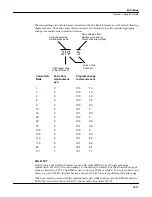
MIDI Mode
The Transmit (XMIT) Page
10-3
Also important: Both the transmit and receive velocity maps should be left at values of Linear
unless you really need to change them. The linear maps will give you the most consistent
results.
If you have a keyboard model of the K2500, keep in mind that the setting of the Veltouch
parameter in Master mode also has an effect on the transmit velocity map.
Pressure Map—Transmit (PressMap)
This is like the VelocMap, but it controls the aftertouch values sent by the K2500 to its MIDI Out
port. Use this exclusively to adjust the response of MIDI devices connected to the K2500’s MIDI
Out port. Changing the pressure map on this page will not affect the response of the K2500’s
sound engine to your MIDI controller. That’s done on the RECV page. See Chapter 17 for
information about editing pressure maps.
Program Change (PChng)
When On, the K2500 will send program change commands to its MIDI Out port when you
select programs or setups from the front panel or from your MIDI controller. Select a value of
Off when you want to change programs on the K2500 but don’t want to send program change
commands to the MIDI Out port. This parameter doesn’t affect the type of program change
command that’s sent; it just determines whether any command is sent at all.
Buttons (Bttns)
If you set the value of the Buttons parameter to On, the System Exclusive (SysEx) messages
generated by your button presses are sent to the MIDI Out port. This enables you to do two
things: control a remote K2500 (or K2000), and record sequences of programming button
presses to a sequencer or SysEx software package.
If you have the MIDI In port of another K2500 (or K2000) connected to the first one’s MIDI Out
port, the second K2500 (or K2000) will respond to every button press on the first K2500 (or
K2000), just as if you were pressing the buttons of the second one. Keep in mind that both
devices must be in exactly the same state (the same page in the same mode, with identical lists
of RAM objects) when you start. Otherwise the button presses you make on the first device
may execute other functions on the second device.
Much more useful is to send streams of button presses to your sequencer. When you dump
them from your sequencer back to the K2500, the K2500 responds as if the buttons were
actually pressed. This enables you to set up a variety of “macros,” which are strings of
commands that can be executed all at once by a single initial command. For example, you can
record a sequence of button presses that enters Disk mode, selects a specific SCSI device, and
loads one or more banks of samples while you do something more entertaining. Again, it’s
important to keep in mind that the state of your K2500 must be identical to its state when you
recorded the sequence of button presses. If you’ve added or deleted any objects stored in RAM,
for example, the sequence of button presses will select different objects when you play back the
button press sequence.
Note: Make sure this parameter is set to Off before you initiate a SysEx dump of any kind. If
this parameter is On when you start a dump, the buttons you press to begin the dump will also
generate SysEx messages, which will probably corrupt the SysEx dump.
Change Setups (ChgSetups)
Choose KeyUp to indicate that you only want setup changes to take place when you’ve
released all currently held notes. Choose Immed to indicate that you want such changes to
happen immediately.




































